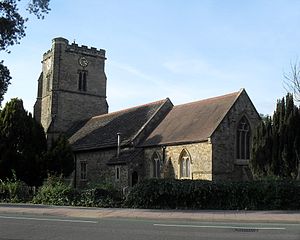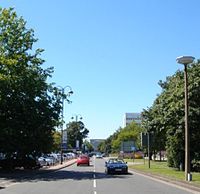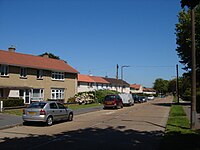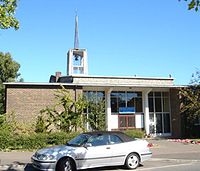Crawley
| Crawley | |
| Sussex | |
|---|---|
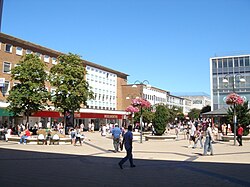 Queen's Square in the town centre | |
| Location | |
| Grid reference: | TQ267365 |
| Location: | 51°6’52"N, 0°11’25"W |
| Data | |
| Post town: | Crawley |
| Postcode: | RH10-11 |
| Dialling code: | 01293 |
| Local Government | |
| Council: | Crawley |
| Parliamentary constituency: |
Crawley |
Crawley is an industrial town in northern Sussex, rubbing against the Surrey border to the north. It is 18 miles north of Brighton and 32 miles north-east of the county town, Chichester. Crawley is a New Town, designated in 1947, though one built on earlier roots.
The major influence on Crawley and its business community is Gatwick Airport just across the border in Surrey but which Crawley has grown contiguous.
Crawley is within the Rape of Lewes.
The area was a centre of ironworking in Roman times. Crawley itself developed slowly as a market town from the 13th century, serving the surrounding villages in the Weald; its location on the main road from London to Brighton brought a passing trade, encouraging the development of coaching inns. It was connected to the railway network in the 1840s.
Contents
New town
Gatwick Airport, now one of Britain's busiest international airports, opened on the edge of the town in the 1940s, encouraging commercial and industrial growth. After the Second World War, the Government planned to move large numbers of people and jobs out of London and into new towns around south-eastern England and enacted the New Towns Act 1946, which nominated Crawley as the site of one of these; it was duly designated in January 1947. A master plan was developed for the establishment of new residential, commercial, industrial and civic areas, and rapid development greatly increased the size and population of the town in a few decades.
The town comprises 13 residential neighbourhoods based around the core of the old market town, and separated by main roads and railway lines. The nearby communities of Ifield, Pound Hill and Three Bridges were absorbed into the new town at different stages of its development. As of 2009, expansion is planned in the west and northwest of the town, in co-operation with a neighbouring council.[1] Economically, the town has developed into the main centre of industry and employment between London and the south coast of Greta Britain. A large industrial area supports industries and services, many of which are connected with the airport, and the commercial and retail sectors continue to expand.
Churches
Crawley's oldest church is St John the Baptist's, between the High Street and the Broadway. It is said to have 13th century origins,[2] but there has been much rebuilding (especially in the 19th century) and the oldest part remaining is the south wall of the nave, which is believed to be 14th century.
The church has a 15th-century tower (rebuilt in 1804) which originally contained four bells cast in 1724. Two were replaced by Thomas Lester of London in 1742; but in 1880 a new set of eight bells were cast and installed by the Croydon-based firm Gillett, Bland & Company.[3][4]
History
Origins
Crawley is on the western edge of the High Weald, which produced iron for more than 2,000 years from the Iron Age onwards.[5] Goffs Park—now a recreational area in the south of the town—was the site of two late Iron Age furnaces.[6] Ironworking and mineral extraction continued throughout Roman times, particularly in the Broadfield area where many furnaces were built.[7]
Crawley itself was founded in the Anglo-Saxon period, possibly as early as the 5th century, and Craw leah: crow meadow or crow clearing.
Crawley is not mentioned in the Domesday Book of 1086,[8] the nearby villages of Ifield and Worth are recorded.[9] The first written record of Crawley dates from 1202, when a licence was issued by King John for a weekly market on Wednesdays.[10]
Crawley grew slowly in importance over the next few centuries, but was boosted in the 18th century by the construction of the turnpike road between London and Brighton. When this was completed in 1770, travel between the newly fashionable seaside resort and London became safer and quicker, and Crawley (located approximately halfway between the two) prospered as a coaching halt.[11] By 1839 the stage coaches offered almost an hourly service to both destinations.[12][13] The George, a timber-framed house dating from the 15th century, expanded to become a large coaching inn, taking over adjacent buildings. Eventually an annexe had to be built in the middle of the wide High Street; this survived until the 1930s.[14] The original building has become the George Hotel; it retains many period features including an iron fireback.[15][16]
Railway age and Victorian era
The Brighton Main Line was the first railway line to serve the Crawley area. A station was opened at Three Bridges (originally known as East Crawley)[17] in the summer of 1841. Crawley railway station, at the southern end of the High Street, was built in 1848 when the Horsham branch was opened from Three Bridges to Horsham. A line was built eastwards from Three Bridges to East Grinstead in 1855. Three Bridges had become the hub of transport in the area by this stage: one-quarter of its population was employed in railway jobs by 1861 (mainly at the London, Brighton and South Coast Railway's railway works near the station).[18] The Longley company, one of South East England's largest building firms in the late 19th century, moved to a site next to Crawley station in 1881.[19] In 1898 more than 700 people were employed at the site.[20]
A major expansion in housebuilding took place in the late 19th century. An area known as "New Town" (unrelated to the postwar developments) was created around the railway level crossing and down the Brighton Road;[18][21] the West Green area, west of the High Street on the way to Ifield, was built up; and housing spread south of the Horsham line for the first time, into what is now Southgate. The population reached 4,433 in 1901, compared to 1,357 a century earlier. In 1891, a racecourse was opened on farmland at Gatwick. Built to replace a steeplechase course at Waddon near Croydon in Surrey, it was used for both steeplechase and flat racing, and held the Grand National during the years of the First World War. The course had its own railway station on the Brighton Main Line.[22]
In the early 20th century, many of the large country estates in the area, with their mansions and associated grounds and outbuildings, were split up into smaller plots of land, attracting haphazard housing development and small farms.[23] By the outbreak of the First First World Warn 1914 Crawley had grown into a small but prosperous town, serving a wide rural area and those passing through on the London to Brighton road. Three-quarters of the population had piped water supplies, all businesses and homes had electricity, and piped gas and street lighting had been in place for 50 years.[18] An airfield was opened in 1930 on land near the racecourse. This was a private concern until the Second World War when it was requisitioned by the Royal Air Force.
New Town
In May 1946, the New Towns Act of 1946 identified Crawley as a suitable location for a New Town; and it was officially designated as such until 9 January 1947.[24] The 5,920 acres of land set aside for the new town were split across the county borders between Sussex and Surrey. Architect Thomas Bennett was appointed chairman of the Development Corporation for the town. A court challenge to the designation order meant that plans were not officially confirmed until December 1947. By this time, an initial plan for the development of the area had been drawn up by Anthony Minoprio.[25] This proposed filling in the gaps between the villages of Crawley, Ifield and Three Bridges.[26] Bennett estimated that planning, designing and building the town, and increasing its population from the existing 9,500 to 40,000, would take 15 years.[27]
Work began almost immediately to prepare for the expansion of the town. A full master plan was in place by 1949. This envisaged an increase in the population of the town to 50,000, residential properties in nine neighbourhoods radiating from the town centre, and a separate industrial area to the north.[25] The neighbourhoods would consist mainly of three-bedroom family homes, with a number of smaller and larger properties. Each would be built around a centre with shops, a church, a public house, a primary school and a community centre.[26] Secondary education was to be provided at campuses at Ifield Green, Three Bridges and Tilgate.[28] Later, a fourth campus, in Southgate, was added to the plans.
At first, little development took place in the town centre, and residents relied on the shops and services in the existing high street. The earliest progress was in West Green, where new residents moved in during the late 1940s. In 1950 the town was visited by Princess Elizabeth, 2 years before her accessiojn to the throne, when she officially opened the Manor Royal industrial area. Building work continued throughout the 1950s in West Green, Northgate and Three Bridges, and later in Langley Green, Pound Hill and Ifield. In 1956, land at "Tilgate East" was allocated for housing use, eventually becoming the new neighbourhood of Furnace Green.[25]
Expectations of the eventual population of the town were revised upwards several times. The 1949 master plan had allowed for 50,000 people, but this was amended to 55,000 in 1956 after the Development Corporation had successfully resisted pressure from the Minister for Town and Country Planning to accommodate 60,000. Nevertheless, plans dated 1961 anticipated growth to 70,000 by 1980, and by 1969 consideration was given to an eventual expansion of up to 120,000.[25]
Extended shopping facilities to the east of the existing high street were provided. The first stage to open was The Broadwalk in 1954, following by the opening of the Queen's Square development by Her Majesty The Queen in 1958. Crawley railway station was moved eastwards towards the new development.[25]
By April 1960, when Thomas Bennett made his last presentation as chairman of the Development Corporation, the town's population had reached 51,700; 2289000 square feet of factory and other industrial space had been provided; 21,800 people were employed, nearly 60% of whom worked in manufacturing industry; and only seventy people were registered as unemployed. The corporation had built 10,254 houses, and private builders provided around 1,500 more. Tenants were by then permitted to buy their houses, and 440 householders had chosen to do so by April 1960.[27]
A new plan was put forward by the Council in 1961 proposing new neighbourhoods at Broadfield and Bewbush, both of which extended outside the administrative area of the then Urban District Council. Detailed plans were made for Broadfield in the late 1960s; by the early 1970s building work had begun. Further expansion at Bewbush was begun in 1974, although development there was slow. The two neighbourhoods were both larger than the original nine: together, their proposed population was 23,000. Work also took place in the area now known as Ifield West on the western fringes of the town.
By 1980, the council identified land at Maidenbower, south of the Pound Hill neighbourhood, as being suitable for another new neighbourhood, and work began in 1986. However, all of this development was undertaken privately, unlike the earlier neighbourhoods in which most of the housing was owned by the council.
In 1999, plans were announced to develop a 14th neighbourhood on land at Tinsley Green to the northeast of the town. However, these were halted when proposals for possible expansion at Gatwick Airport were announced.[29] As of 2008, discussions are underway with Horsham District Council concerning the possible future provision of new housing on Crawley's western fringes; much of the land proposed for development currently lies within Horsham's administrative boundaries.[1]
Geography
Crawley is in the northeastern stretch of Sussex. It is surrounded by smaller towns including Horley, Redhill, Reigate, Dorking, Horsham, Haywards Heath and East Grinstead.
Crawley lies in the Weald between the North and South Downs. Two beds of sedimentary rock meet beneath the town: the eastern neighbourhoods and the town centre lie largely on the sandstone Hastings Beds, while the rest of the town is based on Wealden Clay.[30][31] A geological fault running from east to west has left an area of Weald Clay (with a ridge of limestone) jutting into the Hastings Beds around Tilgate.[31]
The town has no major waterways, although a number of smaller brooks and streams are tributaries for the River Mole which rises as a brook near Gatwick Airport and flows northwards through the whole width of Surrey to the River Thames at Molesey. There are several lakes at Tilgate Park and a mill pond at Ifield which was stopped to feed the Ifield Water Mill.[32]
In 1822 Gideon Mantell, an amateur fossil collector and palaeontologist, discovered teeth, bones and other remains of what he described as "an animal of the lizard tribe of enormous magnitude", in Tilgate Forest on the edge of Crawley. He announced his discovery in an 1825 scientific paper, giving the creature the name Iguanodon.[33] In 1832 he discovered and named the Hylaeosaurus genus of dinosaurs after finding a fossil in the same forest.[34]
Heritage
Crawley Museum[35] is based in Goffs Park. Stone Age and Bronze Age remains discovered in the area are on display, as well as more recent artefacts including parts of Vine Cottage, an old timber-framed building on the High Street which was once home to former Punch editor Mark Lemon and which was demolished when the ASDA development was built.[10]
Crawley has:
- Three Grade I listed buildings:
- the parish church of St Margaret in Ifield
- the parish church of St Nicholas, Worth
- Friends Meeting House in Langley Lane, Ifield
- Twelve Grade II* listed buildings and
- Eighty-five Grade II listed buildings.[36]
Outside links
| ("Wikimedia Commons" has material about Crawley) |
References
- ↑ 1.0 1.1 "West and North West of Crawley". Horsham District Council & Crawley Borough Council. 2006–2009. Archived from the original on 6 December 2007. http://web.archive.org/web/20071206125102/http://194.201.99.228/Index.htm. Retrieved 29 October 2009.
- ↑ "Diocese of Chichester: St John the Baptist, Crawley". A Church Near You website. Oxford Diocesan Publications Ltd. 2007. http://www.acny.org.uk/venue.php?V=4860. Retrieved 13 September 2007.
- ↑ "St John the Baptist Parish Church, Crawley, West Sussex - 22nd April 2004". The Roughwood website. Mark Collins. 2007. http://www.roughwood.net/ChurchAlbum/WestSussex/Crawley/CrawleyStJohnBaptist2004.htm. Retrieved 12 March 2008.
- ↑ "Dove Details". Dove's Guide for Church Bell Ringers website. Sid Baldwin, Ron Johnston and Tim Jackson on behalf of the Central Council of Church Bell Ringers. 24 February 2008. http://dove.cccbr.org.uk/detail.php?searchString=Crawley&Submit=++Go++&DoveID=CRAWLEY+WS. Retrieved 12 March 2008.
- ↑ "About The High Weald: The Iron Story". High Weald AONB Unit website. High Weald AONB Unit. 2008. Archived from the original on 7 August 2007. http://web.archive.org/web/20070807043509/http://www.highweald.org/text.asp?PageId=16. Retrieved 2 April 2008.
- ↑ "Life in Late Iron Age Sussex: Trade & Industry". Romans In Sussex website. The Sussex Archaeological Society. 2008. http://www.romansinsussex.co.uk/level3/themes/life_in_late_iron_age_sussex_trade_indus.asp. Retrieved 2 April 2008.
- ↑ "Life in Roman Sussex: Crafts & Industry: Weald Iron Industry". Romans In Sussex website. The Sussex Archaeological Society. 2008. http://www.romansinsussex.co.uk/level3/themes/life_roman_britain/crafts_industry_iron.asp. Retrieved 2 April 2008.
- ↑ Salzman, L. F. (ed) (1940). "A History of the County of Sussex: Volume 7 – The Rape of Lewes. Parishes: Crawley". Victoria County History of Sussex. British History Online. pp. 144–147. https://www.british-history.ac.uk/report.aspx?compid=56939. Retrieved 30 October 2009.
- ↑ "Crawley Borough Council: St Margaret's Church". Crawley Borough Council website. Crawley Borough Council. 2008. http://www.crawley.gov.uk/stellent/idcplg?IdcService=SS_GET_PAGE&ssDocName=INT009967. Retrieved 28 March 2007.
- ↑ 10.0 10.1 Cole 2004b, Unpaginated.
- ↑ Gwynne 1990, p. 98.
- ↑ Cole 2004a, p. 56.
- ↑ s.n. 1839, p. 681.
- ↑ "Crawley High Street". Crawley Borough Council website. Crawley Borough Council. 2007. http://www.crawley.gov.uk/stellent/idcplg?IdcService=SS_GET_PAGE&strCSS=PB1_SS_MAIN&ssDocName=INT009956. Retrieved 3 August 2007.
- ↑ "Crawley Town Walk" (PDF). Crawley Borough Council website. Crawley Borough Council. 2007. http://www.crawley.gov.uk/stellent/groups/public/documents/otherdocs/int037605.pdf. Retrieved 3 August 2007.
- ↑ National Heritage List 1187088: Crawley
- ↑ David Palmer (2003). "A brief history of Maidenbower" (PDF). Maidenbower Village website. Stuart Cummings. http://www.maidenbower.org.uk/history/palmerhistory.pdf. Retrieved 6 September 2007.
- ↑ 18.0 18.1 18.2 Gray 1983, p. 9.
- ↑ Hudson, T.P. (Ed) (1987). "Ifield: Economic History". A History of the County of Sussex: Volume 6 Part 3. British History Online. http://www.british-history.ac.uk/report.aspx?compid=18407. Retrieved 3 March 2008.
- ↑ Gwynne 1990, p. 119.
- ↑ Cole 2004a, p. 62.
- ↑ Gwynne 1990, p. 146.
- ↑ Gray 1983, pp. 11–12.
- ↑ London Gazette: no. 37849, p. 231, 10 January 1947. Retrieved 30 October 2007.
- ↑ 25.0 25.1 25.2 25.3 25.4 Hudson, T.P. (Ed) (1987). "Crawley New Town". A History of the County of Sussex: Volume 6 Part 3: Bramber Rape (North-Eastern Part) including Crawley New Town. British History Online. http://www.british-history.ac.uk/report.asp?compid=18414. Retrieved 31 July 2007.
- ↑ 26.0 26.1 "New Town History". Crawley Borough Council website. Crawley Borough Council. 2005. http://www.crawley.gov.uk/stellent/idcplg?IdcService=SS_GET_PAGE&strCSS=PB1_SS_MAIN&nodeId=241. Retrieved 31 July 2007.
- ↑ 27.0 27.1 Thomas Bennett (architect) (January 1961). "Crawley after Thirteen Years". Town & County Planning XXIX (I): 18–20.
- ↑ "First proposed structure plan, 1947". Nostalgia: A Crawley Observer Supplement (2): 3. 1995.
- ↑ Janet Treagus (15 May 2007). "Council wins fight against new neighbourhood". Crawley Borough Council website. Crawley Borough Council. http://www.crawley.gov.uk/stellent/idcplg?IdcService=SS_GET_PAGE&ssDocName=PR1966&ssTargetNodeId=99. Retrieved 21 August 2007.
- ↑ "Geology of Surrey and Sussex, after Woodward (1904), based on Reynolds (1860; 1889)". Geology of Great Britain—an Introduction with Geological Maps (from the website of Southampton University). Ian West and Tonya West. 2008. http://www.soton.ac.uk/~imw/jpg/sussex.jpg. Retrieved 1 April 2008.
- ↑ 31.0 31.1 Gwynne 1990, pp. 3–4.
- ↑ "Ifield Mill Pond". Crawley Borough Council website. Crawley Borough Council. 2007. http://www.crawley.gov.uk/stellent/idcplg?IdcService=SS_GET_PAGE&ssDocName=INT010149. Retrieved 10 August 2007.
- ↑ Thomson, Keith Stewart (March–April 2006). "American Dinosaurs: Who and What Was First". American Scientist 94 (2): 209. doi:10.1511/2006.58.209.
- ↑ "The Discovery of Hylaeosaurus, 1833". The Linda Hall Library, Kansas City website. Linda Hall Library. 2003. Archived from the original on 8 May 2008. http://web.archive.org/web/20080508200032/http://www.lhl.lib.mo.us/events_exhib/exhibit/exhibits/dino/man1833.htm. Retrieved 1 April 2008.
- ↑ "Crawley Museum Centre". Culture24 website. 2007. http://www.culture24.org.uk/se000454. Retrieved 2 August 2007.
- ↑ "Listed Buildings in Crawley" (PDF). Crawley Borough Council website: Listed Buildings in Crawley. Crawley Borough Council. 2008. http://www.crawley.gov.uk/stellent/groups/public/documents/adviceguidance/int116583.pdf. Retrieved 6 November 2008.
Books
- Bastable, Roger (2004). Then & Now: Crawley. Stroud: Tempus Publishing. ISBN 0-7524-3063-7.
- Body, Geoffrey (1984). PSL Field Guide: Railways of the Southern Region. Cambridge: Patrick Stephens. ISBN 0-85059-664-5.
- Cole, Belinda (2004a). Crawley: A History & Celebration. Salisbury: Frith Book Company. ISBN 1904938191.
- Cole, Belinda (2004b). Crawley: An Illustrated Miscellany. Salisbury: Frith Book Company. ISBN 1904938744.
- Crawley Borough Council (1997). Crawley: Official Guide. Wallington: Local Authority Publishing Co Ltd.
- Gray (ed.), Fred (1983). Crawley: Old Town, New Town. Paper No. 18 (Centre for Continuing Education, University of Sussex ed.). Falmer: University of Sussex. ISBN 0-904212-21-8.
- Green, Jeffrey; Peter Allen (1993). Crawley New Town in old photographs. Stroud: Alan Sutton Publishing. ISBN 0-7509-0472-0.
- Gwynne, Peter (1990). A History of Crawley. Chichester: Phillimore & Company. ISBN 0-85033-718-6.
- Kraemer-Johnson, Glyn; John Bishop (2005). Southdown Days. Hersham: Ian Allan Publishing. ISBN 0-7110-3077-4.
- Mitchell, Vic; Keith Smith (1986a). Southern Main Lines: Three Bridges to Brighton. Midhurst: Middleton Press. ISBN 0-906520-35-5.
- Mitchell, Vic; Keith Smith (1986b). Southern Main Lines: Crawley to Littlehampton. Midhurst: Middleton Press. ISBN 0-906520-34-7.
- s.n. (1839). Pigot's Directory of Sussex. London and Manchester: Pigot & Co. WSC13002. http://www.historicaldirectories.org/hd/pageviewer.asp?pnum=31&zoom=&dn=WSC13002tif&fn=.
